Top 10 Best Online Sorting Courses
In interviews for technical positions, most product-based organizations place a premium on a candidate's understanding of algorithms and data structures. Data ... read more...structures and algorithms are essential for becoming a proficient programmer since they considerably increase one's problem-solving abilities. If you want to learn about sorting and algorithms, one of these Best Online Sorting Courses can help you enhance your problem-solving skills and prepare for interviews in the software engineering and data science sectors.
-
Every developer should have a basic understanding of algorithms. Algorithms for searching and sorting are a typical topic in technical interviews. This on-demand course will help you stay one step ahead of your competition by teaching you these skills. Python is the most widely used and accessible programming language, and its popularity grows year after year.
Not only can knowing how to search and sort algorithms aid you in your job hunt, but it will also improve your computational thinking abilities. With the solid foundation provided by this course, you will be able to dig into more sophisticated algorithms. You'll plunge into the realm of algorithms through an interesting and practical learning experience, complete with thorough and informative presentations, animations, explanations, and exercises.
This course is unusual in that it focuses on providing visual and extensive explanations of how the algorithms function behind the scenes, so you will not only learn how to implement them in Python, but you will also be able to describe and visualize the phases of the process given a specific input.
Requirements:
- Python 3 installed
- Basic Python Knowledge
- Basic Knowledge of Recursion
- A fast refresher on lists, tuples, and algorithmic time complexity may be found in the Quick Refresher section
Who this course is for:
- New Python programmers who have mastered the fundamentals.
- Developers that want to add more algorithms to their toolkit.
- Students of Computer Science and self-taught developers.
- Programmers who need to brush up on their skills.
- Developers who are in the process of preparing for a job interview.
Course Rating: 4.8/5
Enroll here: https://www.udemy.com/course/python-searching-sorting-algorithms/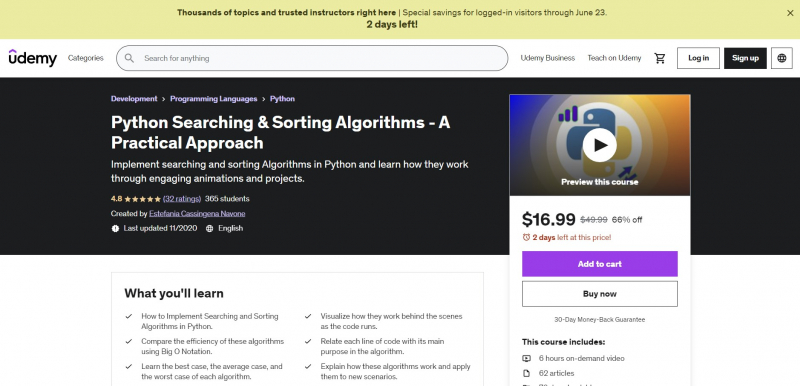
https://www.udemy.com/ 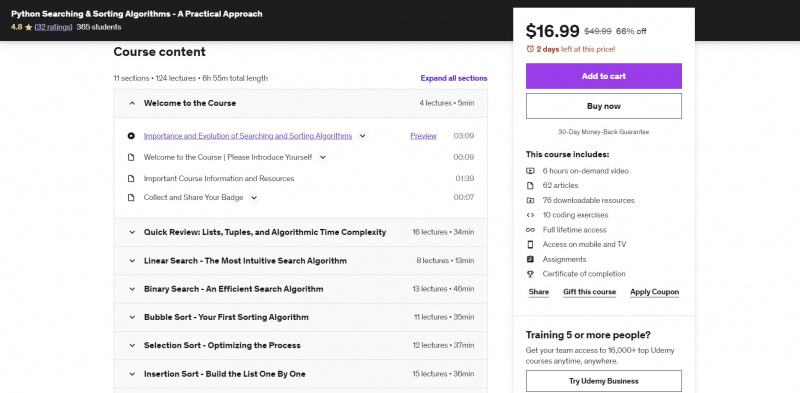
https://www.udemy.com/ -
Finding, Sorting, & Filtering Data in Microsoft Excel is also one of the Best Online Sorting Courses. You will get experience with Microsoft Excel's searching, sorting, and filtering tools in this assignment. You will alter spreadsheet data using Excel for the web's free edition of Office 365 to make it more beneficial for sound business decisions. You will only isolate the necessary data using a filter. The information may then be arranged logically to create the knowledge required for informed decision-making. Your teacher will lead you through these stages in a video that plays in split-screen alongside your workspace.
You will first log in to the free edition of Microsoft Excel using the Chrome browser and upload an existing spreadsheet. The next step involves finding a specific cell value in a spreadsheet and automatically replacing it with a different value using Excel's Find & Select tool. Alternately, you may utilize Excel's sort tools to arrange rows in ascending and descending order based on certain column values. Utilizing Excel's filter tools to choose just rows that satisfy particular requirements is another skill you may develop. In a spreadsheet, you may finally add a new field, apply a filter, and sort the output of the calculation.
This course offers:
- Approx. 1 hour to complete
- Intermediate
- No download needed
- Split-screen video
- Subtitles: English
- Desktop only
Course Rating: 4.8/5
Enroll here: https://www.coursera.org/projects/finding-sorting-filtering-data-microsoft-excel
https://www.coursera.org/ 
https://www.coursera.org/ -
It is one of the Best Online Sorting Courses. This course covers the fundamentals of algorithm design and analysis, array sorting algorithms, hash functions, priority queues, and applications like Bloom filters. As a part of the Master of Science in Data Science (MS-DS) program at CU Boulder, which is available on the Coursera platform, students may take Algorithms for Searching, Sorting, and Indexing for academic credit. The MS-DS is a multidisciplinary degree that brings together academics from the Applied Mathematics, Computer Science, Information Science, and other departments at CU Boulder.
The MS-DS is best suited for people with a wide variety of undergraduate education and/or professional experience in computer science, information science, mathematics, and statistics since it has performance-based admissions and no application procedure. This course will help you grasp key ideas and will include practice problems so that you can easily complete online coding challenges and code-athons. The main issues in this area of specialty include randomized algorithms, asymptotic ("Big-oh") notation, and sorting and searching (QuickSort, contraction algorithm for min cuts).
This course offers:
- Flexible deadlines: Reset deadlines in accordance to your schedule.
- Certificate: Earn a Certificate upon completion
- 100% online
- Intermediate Level
- Approx. 35 hours to complete
- Subtitles: English
Course Rating: 4.7/5
Enroll here: https://www.coursera.org/learn/algorithms-searching-sorting-indexing
https://www.coursera.org/ 
https://www.coursera.org/ -
Through live animation, you will learn about the most popular subjects related to data structures and algorithms in this course. The data structure is a fundamental concept in computer science, and it is utilized in fields such as artificial intelligence, operating systems, and graphics. The goal of this course is to use visuals and live animation to convert complexity into simple. The most common data structures are shown, including queues, stacks, linked lists, graphs, trees, heap data structures, sorting algorithms, and searching algorithms. Anyone interested in data structures and algorithms should take this course.
The implementation covers all sorting and searching methods. Python is the primary programming language. However, only rudimentary programming abilities are necessary, and these skills are only required for sorting and searching algorithms, which are described using the Python programming language. All lectures start from the beginning, so don't worry if you don't think your prior knowledge is sufficient for this course. In fact, both implementation and examples are presented in a straightforward manner.
Requirements:
- Basic Understanding of python programming language for sorting and searching algorithms
- No experience with data structures or algorithms is required
Who this course is for:
- Anyone who is interested in learning Data Structure and Algorithms
- Students currently studying computer science
Course Rating: 4.5/5
Enroll here: https://www.udemy.com/course/fundamental-of-data-structure-and-algorithms/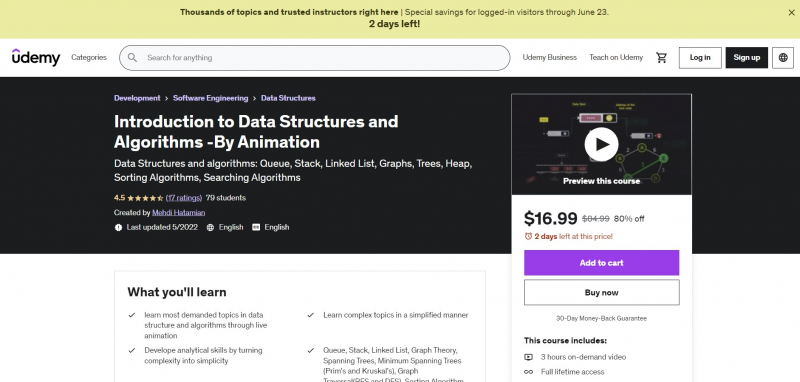
https://www.udemy.com/ 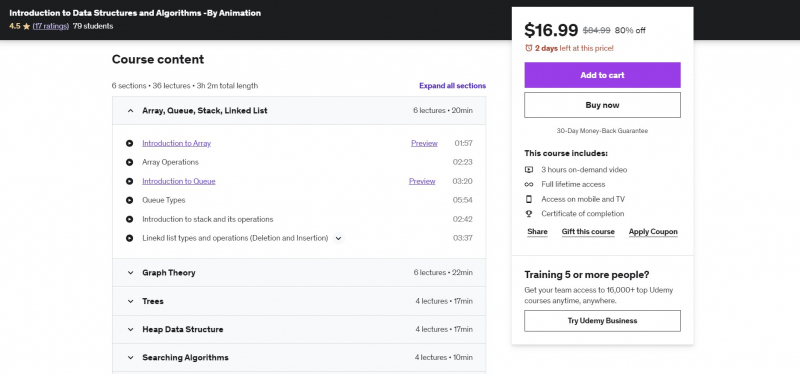
https://www.udemy.com/ -
Sorting Algorithms from Beginner to Expert is among the Best Online Sorting Courses. This is an online Comprehensive Course with over 5 hours of Videos covering various Sorting Algorithms in depth utilizing Visual and Animated presentations. Sorting algorithms are discussed with an example, followed by their algorithms, line-by-line coding in C++, and complexity analysis in BIG O Notation. You may evaluate your understanding of the material by taking the Practice exam (Assignment and Quiz) based on Interview Questions at the conclusion of the course.
Sorting algorithms are used in every computer language. While most programming languages include simple sorting techniques, understanding how they function may be beneficial. Some of the most common sorting algorithms will be taught in this course! Selection sort, bubble sort, insertion sort, merge sort, and their sequence of difficulties are covered in this course. Although this course is taught in C++, the ideas may be applied to any programming language. This course covers the following algorithms and topics: Bubble Sort, Merge Sort, Two-Way Merge Sort, Quick Sort, and Insertion Sort are all examples of sorting techniques.
Requirements:
- Basic of any Programming Language preferably C/C++
Who this course is for:
- Students looking to learn Sorting Algorithms
Course Rating: 4.5/5
Enroll here: https://www.udemy.com/course/sorting-algorithms-from-beginner-to-expert/
https://www.udemy.com/ 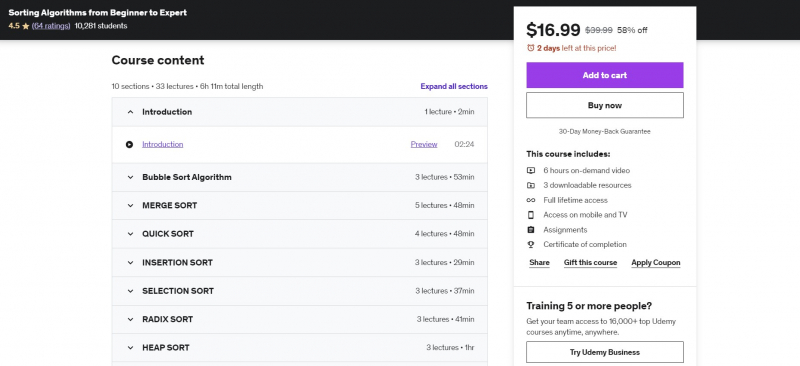
https://www.udemy.com/ -
When you need to arrange the data for your user in a certain sequence, sorting algorithms are critical to the development of effective and strong systems. By doing this, it may be much quicker for a person or even a machine to interpret and comprehend this data in order to make business choices. By the conclusion of this project, you will understand how to build an application that uses a number of essential sorting algorithms to arrange Missouri Tax Data in ascending order.
You'll discover how to work with actual data sets and see how different sorting algorithms use memory and time differently. You will also learn how to create a readable implementation and how to analyze sorting algorithms. Finally, you will discuss the conditions under which each type of sorting algorithm performs best. Students will be able to progress to more complex algorithms and data structures after finishing this assignment. With a working grasp of Java's arrays, recursion, and loops, they are all also simple to implement.
This course offers:
- Approx. 2 hours to complete
- Intermediate
- No download needed
- Split-screen video
- Subtitles: English
- Desktop only
Course Rating: 4.5/5
Enroll here: https://www.coursera.org/projects/sorting-tax-data-using-efficient-sorting-algorithms-in-java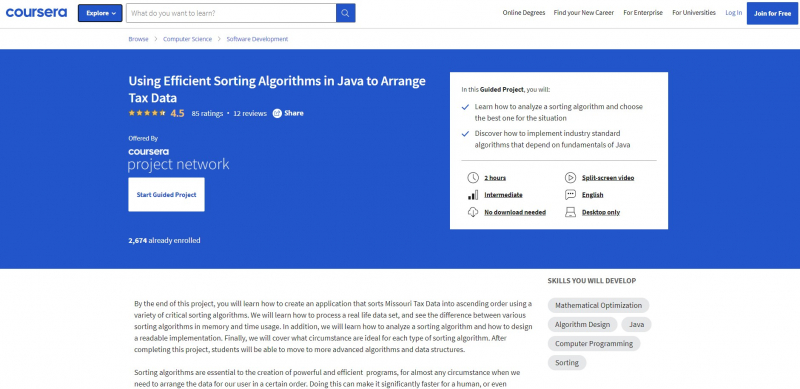
https://www.coursera.org/ 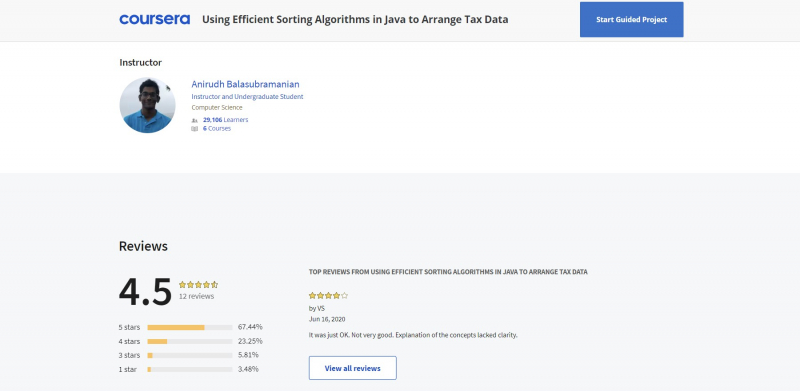
https://www.coursera.org/ -
A Sorting Algorithm rearranges the members of an array or list based on a comparison operator on the elements. To determine the new order of items in the corresponding data structure, the comparison operator is utilized. If the data is disorganized and unsorted, you will have to look for a certain piece of information one by one each time. This course will teach you how to use sorting algorithms in C++. From novice to professional. A unique sorting method is included in each chapter.
You'll be comfortable with both comparison-based and non-comparison-based sorting techniques. Bubble sort, insertion sort, selection sort, merge sort, and quicksort are some of the most common. Counting sort and radix sort, for example, are notable non-comparison based algorithms. So these are the issues you'll go through one at a time. C++ includes both theory and implementation! You can move on to the topic of algorithms and data structures after learning about the fundamental sorting procedures. Let's get this party started!
Requirements:
- Basic knowledge of C++
- C++ compiler
Who this course is for:
- Anyone interested in learning C++ sorting algorithms, whether a university student or a software developer
Course Rating: 4.4/5
Enroll here: https://www.udemy.com/course/sorting-algorithms-in-c/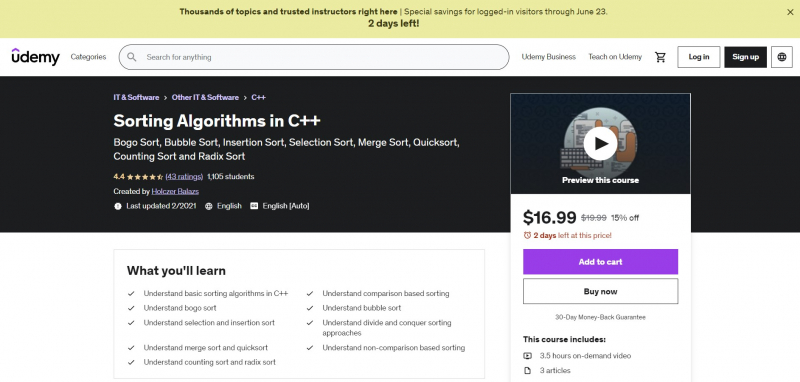
https://www.udemy.com/ 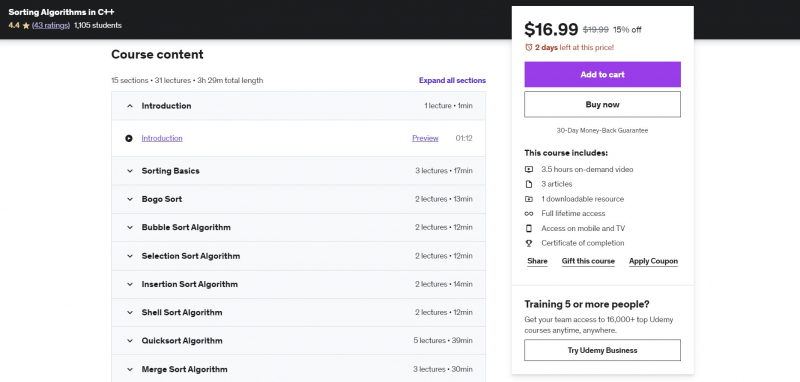
https://www.udemy.com/ -
Through live animation, you will learn about the most common sorting and searching algorithms in this course. This course includes visualizations of sorting algorithms and visualizations of searching techniques. When you want to sort an array, or arrange items in a certain order, you must use sorting algorithms, and when you want to discover a specific element inside an array, you must use a searching method.
Illustrations and live animation are used to enhance this lesson. All of the specifics for sorting an array or looking for a certain element are covered. Heap sort, rapid sort, merge sort, selection sort, bubble sort, insertion sort, bucket sort, counting sort, radix sort, linear search, and binary search are all covered in this course. Anyone who is interested in algorithms should take this course.
Python is the primary programming language. However, just rudimentary programming abilities are necessary. All lectures start from the beginning, so don't worry if you don't believe your prior knowledge is sufficient for this lesson. In fact, both implementation and examples are presented in a straightforward manner. If you have any questions, please do not hesitate to inquire.
Requirements:
- Basic Understanding of python programmimng language
Who this course is for:
- Anyone who is interested in learning sorting and searching algorithms
Course Rating: 4.4/5
Enroll here: https://www.udemy.com/course/sorting-and-searching-algorithms-python/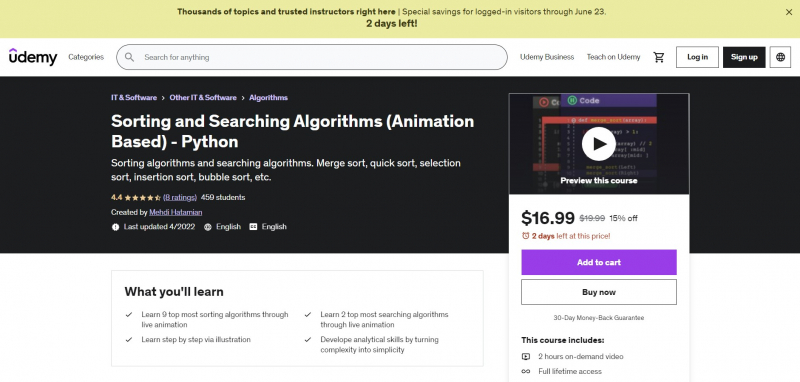
https://www.udemy.com/ 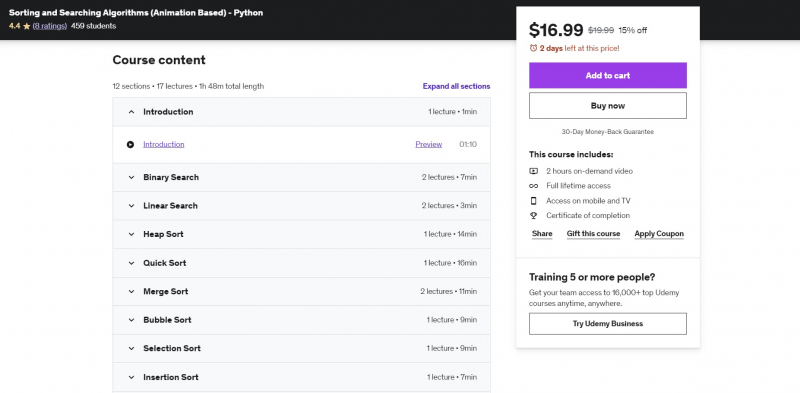
https://www.udemy.com/ -
Good day! You will see the algorithms' workflow and get the feel of them in this course on searching and sorting algorithms. You will put what you learned about Cpp programming into practice. Each algorithm will be compared and contrasted in terms of time, space, flexibility, and stability. Understanding the common use cases, process, time complexity, and implementation of each technique will be possible.
An algorithm used to organize the items in a list is known as a sorting algorithm. The two orders that are most often employed are numerical order and lexical order. The effectiveness of other algorithms (like search and merge algorithms) that need input data to be in sorted lists must be maximized, hence efficient sorting is crucial.
You may learn how to create and put sorting and searching algorithms into software. You may see - actually clearly envisage - the typical data structures and the algorithms applied to them, or you can comprehend the trade-offs, complexity, and use-cases for different types of sort and search algorithms. Not only that, but you'll also receive 80+ competitive code problems to practice and test your knowledge!
Requirements:
- A basic knowledge in Data Structures and Programming is preferred
Who this course is for:
- Beginner Programmers
Course Rating: 4.3/5
Enroll here: https://www.udemy.com/course/searching-and-sorting-algorithms/
https://www.udemy.com/ 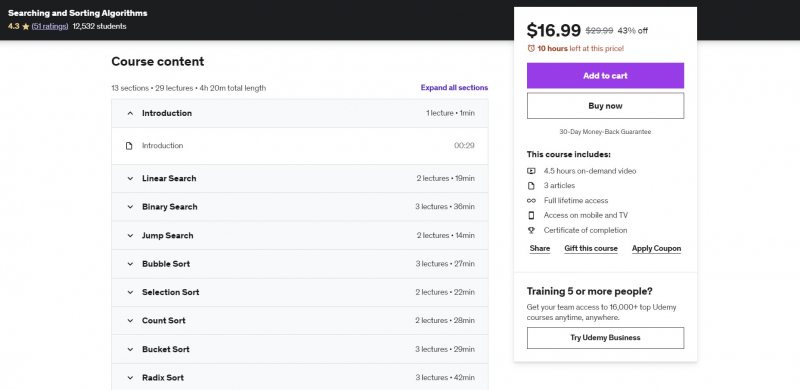
https://www.udemy.com/ -
After completing this course, you will be able to convert sorting algorithms into code in the easiest way possible. Master the numerous advantages by knowing when to use which sorting method. You also understand how sorting affects run-time and how sorting takes extra space, with some methods being more successful than others.
You must have a fundamental comprehension of the underlying programming ideas if you wish to become a successful programmer. The more programming ideas you grasp, the more Python challenges you'll be able to address. This course explains some basic sorting and searching algorithms in a straightforward and understandable manner.
To gain a grasp of it, you will be learning as you go and implementing various sorting and searching methods. The course comes with a 30-day money-back guarantee, so if you're not happy, you may get your money back. Also, if you have any questions, please do not hesitate to contact me personally.
Requirements:
- Understanding of a simple Python program (if, while and function calls)
- Simple understanding of Python lists
Who this course is for:
- Beginner Python developer interested in learning the basics of sorting and searching.
- Python developer who wants to learn more about how to use Python to solve issues in general.
Course Rating: 4.1/5
Enroll here: https://www.udemy.com/course/become-a-skilled-python-programmer-sorting-and-searching/
https://www.udemy.com/ 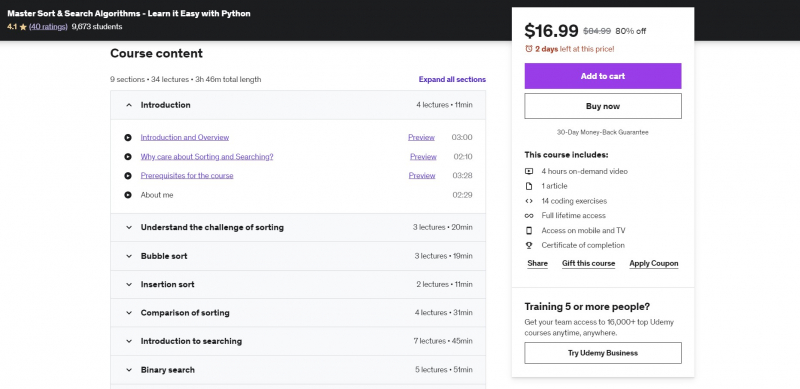
https://www.udemy.com/































